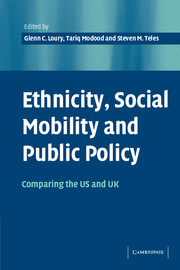Book contents
- Frontmatter
- Contents
- List of figures
- List of tables
- List of contributors
- Acknowledgements
- Introduction
- Part I Historical overviews
- Part II Informal social networks
- Part III Formal structures
- 9 Educational progress for African-Americans and Latinos in the United States from the 1950s to the 1990s: the interaction of ancestry and class
- 10 The educational attainments of ethnic minorities in Britain
- 11 Why America's black–white school achievement gap persists
- 12 Networks and niches: the continuing significance of ethnic connections
- 13 Nonwhite origins, Anglo destinations: immigrants in the USA and Britain
- 14 Social mobility of ethnic minorities
- 15 Ethnic minorities, employment, self-employment, and social mobility in postwar Britain
- Part IV Political institutions and processes
- Part V Normative analysis
- Author index
- Subject index
- References
13 - Nonwhite origins, Anglo destinations: immigrants in the USA and Britain
Published online by Cambridge University Press: 22 September 2009
- Frontmatter
- Contents
- List of figures
- List of tables
- List of contributors
- Acknowledgements
- Introduction
- Part I Historical overviews
- Part II Informal social networks
- Part III Formal structures
- 9 Educational progress for African-Americans and Latinos in the United States from the 1950s to the 1990s: the interaction of ancestry and class
- 10 The educational attainments of ethnic minorities in Britain
- 11 Why America's black–white school achievement gap persists
- 12 Networks and niches: the continuing significance of ethnic connections
- 13 Nonwhite origins, Anglo destinations: immigrants in the USA and Britain
- 14 Social mobility of ethnic minorities
- 15 Ethnic minorities, employment, self-employment, and social mobility in postwar Britain
- Part IV Political institutions and processes
- Part V Normative analysis
- Author index
- Subject index
- References
Summary
Until very late in the twentieth century, the USA was the setting for most statistical studies of ethnic inequality; Canada ranked second, Australia a distant third. This situation reflected the high proportions of immigrants in these countries and the large amount of information that researchers could obtain about the foreign born. After World War II, however, the numbers immigrating to Europe began to grow. Today, annual immigration to Europe is twice as high as annual immigration to the “New World” (Widgren 1994). As a result, Europe's immigrants have attracted increasing amounts of research attention. Indeed, several European nations now field surveys explicitly designed to illuminate the experiences of their ethnic minorities.
Studies of Britain's ethnic minorities stand at the forefront of this new scholarship. The first survey specifically devoted to this population was launched in 1966; more exhaustive studies followed in 1974, 1982, and 1994. To be sure, in the early years, the data collected in these surveys were available only to a small group of scholars. But today researchers can obtain the responses to the 1994 National Survey of Ethnic Minorities on CD-ROM from the Data Archive at Essex University. Of course, already in the late 1980s, the British Labour Force Survey was available on computer tape; by 1993 the UK Census was accessible on the University of Manchester's mainframe. And each year new sources of information on Britain's immigrants and minorities become available.
- Type
- Chapter
- Information
- Ethnicity, Social Mobility, and Public PolicyComparing the USA and UK, pp. 363 - 392Publisher: Cambridge University PressPrint publication year: 2005
References
- 1
- Cited by



